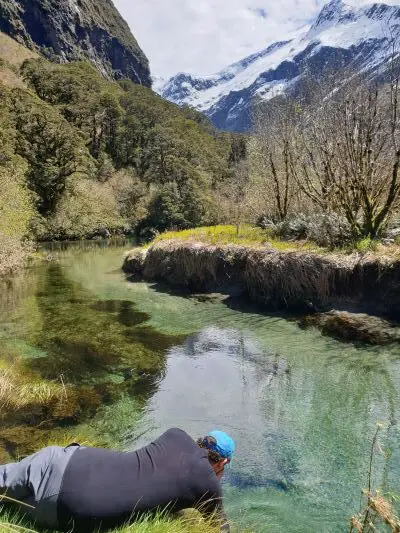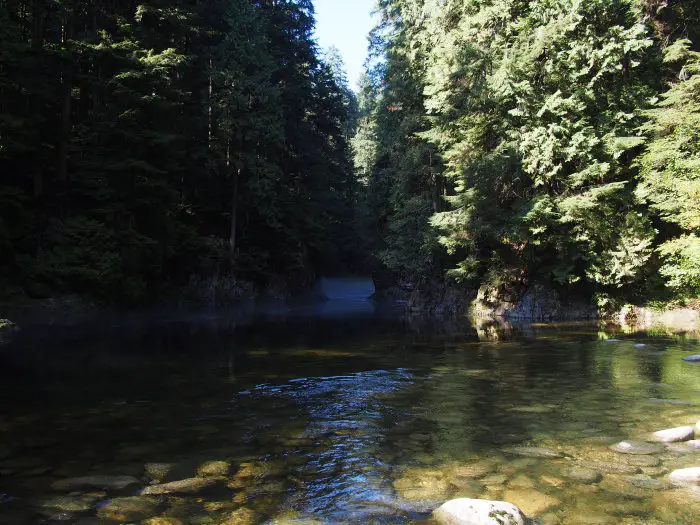It is generally advised not to drink water from trout streams or lakes without first treating it. That is because pathogens such as Giardia or Cryptosporidium can survive in even clean, cold mountain streams. Side effects is usually severe diarrhea.
While most people who drink stream water do not get sick it always means a possibility. In most wilderness areas pathogen concentrations are low, and it will take drinking an enormous volume of water to pick up an infection. But, infections can and do happen.
In an interview published on the Utah University Health page this interview Dr. Troy Madsen, says that in the Emergency Medicine department of University Utah they only rarely see people sick from drinking mountain water. When they do, by far the most common illness is profuse diarrhea.
Dr Madsen goes on to advise, that untreated stream water should only be drunk in an emergency, for example, to prevent dehydration. In most situations, it should be treated before drinking
If in any doubt whatsoever, it is best to treat or boil natural water before drinking.
There are many options, for example, Iodine tablets work great, take up next to no space, and only cost a few dollars for a week’s supply. On the downside, they do make the water taste horrible and they do not remove toxins or chemicals.
You can also use a simple water filter such as the Sawyer Squeeze or the MSR TrailShot. There are heaps of options on the market. They are lightweight, easy to use and they don,t take up much room in a backpack.
Boiling is also a great way to sterilize water, but it takes forever to cool down on a hot summer day. It also does not destroy all toxins and it does not remove heavy metals. But I will drink water from home if fishing in waters with elevated levels of industrial pollutants.
The most common pathogens found in freshwater streams.
There are several types of pathogens that can occur in cold freshwater streams that to the naked eye looks pristine. These pose a risk to people drinking from them.
- Giardia: Giardia is a microscopic parasite that can cause severe diarrhea, cramps, and dehydration.
- Cryptosporidium: Cryptosporidium is another parasite that can cause gastrointestinal illness, including diarrhea, vomiting, and stomach cramps.
- E. coli: E. coli is a type of bacteria that can cause serious illness, including kidney failure, if ingested.
- Salmonella: Salmonella is another type of bacteria that can cause food poisoning, including symptoms such as diarrhea, fever, and stomach cramps.
- Cyanbacteria: Commonly known as blue green algae, this photosynthesix bacteria can produce toxins which can cause skin rash, diarrhea, vomiting and liver damage.
It is important to note that these pathogens can be present in water even if it appears clean and clear. Therefore, it is recommended to treat all water from coldwater streams before consuming it to reduce the risk of illness.
How to minimize risk when drinking untreated stream water
Sometimes, the only choice is to drink untreated stream water. Here are some options that can reduce the risk of getting sick.
- Only drink water which is flowing through a ‘wilderness’ area without inhabitants or farmland. Some very extensive ranching, such as a handful of cows is usually okay but no intensive agriculture.
- Know the origin of the water. If I know it is seeping down from some high mountain range, or from some remote valley in a national park it is usally okay to drink. On the other hand, if it’s origins is say an irrigation discharge I will avoid drinking it.
- Never drink water downstream of a town, major campsite, swimming hole or other area where people accumulate. Even if the town was 100 miles upstream I am not going to drink it. I will even hesitate to drink from a crystal clear stream crowded by other anglers. You know someone is going to pee into the water.
- The stream must be cold and clear and not stagnant. There must be no run-off from recent rain, just residue flow. The UV from the sun does purify and kill off many microbes. That is why the water must be cleared. The one exception is freezing water full of glacier flour, that can sometime have a blue tinge.
- There must be no algae bloom or discolouration to the water. Some algae, (In particular Blue Green Algae) produces toxins which can be very dangerous. I have read too many reports of algae killing dogs, birds and causing serious illness in humans. If the water is warm do not drink it, if there is algae floating in the water do not drink it. If it smells strange, do not drink it.
- Try and source the water from the middle of a pool. I avoid drinking moving, turbulent water. The reasoning is simple. Moving water is all mixed up and the pathogens can be anything in the water column. While in still water, the pathogens and sediment usually sinks towards the bottom. By taking my water from a still section, it helps minimize the risk.
- Make sure there are few or no waterfowls. Ducks, geese can carry diseases. Why take the risk.
- If I am fishing or camping in an area I am not familiar with, check up with locals who know the area well before deciding to drink the water or not.
How to treat stream water to make it safer to drink
| Treatment Option | Pros | Cons |
|---|---|---|
| Boiling | Effectively kills all pathogens and viruses, including protozoa and bacteria | Time-consuming and requires a heat source such as a stove or fire, can alter taste of water, does not remove chemicals or pollutants. Can take a while to cool down to a drinkable temperature. |
| Portable Water Filters | Removes most bacteria, protozoa, and some viruses, lightweight and easy to carry | May not remove all pathogens, clogs easily and requires cleaning/replacement, does not remove chemicals or pollutants |
| Water Purification Tablets | Lightweight and easy to carry, can effectively kill most pathogens and viruses | Takes time to dissolve, may leave an unpleasant taste, does not remove chemicals or pollutants |
| UV Light Purifiers | Kills most bacteria, protozoa, and viruses, lightweight and easy to carry | Requires batteries and/or a power source, may not be effective against all pathogens, does not remove chemicals or pollutants. Does not work if water is cloudy or contains sediment. |
| Chemical Water Treatment | Lightweight and easy to carry, can effectively kill most pathogens and viruses | May leave an unpleasant taste, can take time to work, does not remove chemicals or pollutants |
It’s important to note that while these treatment options can be effective, they are not foolproof and may not remove all potential contaminants in stream water. It’s always best to follow the guidelines mentioned earlier, such as sourcing water from a clean source and avoiding stagnant water, to minimize the risk of contamination.
What are my personal thoughts?
Everyone in the outdoors seems to be split into two camps.
Those who religiously treat every drop of water, and those of us who just drink it straight.
So on a hot summer day while fishing a cold trout stream? I usually drink the water straight and not think twice about it. I have friends who tell me, that I must have a very strong stomach.
I doubt my immune system is anything special. The risk of illness from drinking natural water is actually very low for anyone but the immunocompromised.
Over my lifetime I have drank a lot of water from many mountain streams. I been drinking it sense I was knee high to a grasshopper while hiking the mountain trails with my parents.
I have drunk stream water in the Rocky’s, New Zealand and the Scottish Highlands. I have never been ill, and often the water tastes amazing. I was a bit hesitant to drink the highland waters at first, the entire area was a bit marshy but some of the locals assured me any streams flowing down from the peaks were safe. So, I trusted them and it tasted great.
I have also met many other people in the outdoors who frequently drink the water while out hiking, fishing, hunting. They also never get sick or at least talk about it.
There was one occasion when I might have gotten sick from drinking natural water. I hiking in Greece, and I drank ‘avalanche’ melt on the slopes of Mount Olympus.
The locals said it was ‘probably’ safe, but not treated. That night I had hallucinations and vomited quite a bit, I was seriously fatigued the next day. I do not know whether the water caused my illness or the generous amounts of dodgy Greek wine. In either case, I never trusted the meltwater in Greece again.
I have a few unpleasant experiences, that have not resulted in illness.
I once was drinking water from a trout river in New Zealand, when I walk around the corner and discovered a hunter had left the guts of a freshly shot deer in the water. Yum, I never got sick.
I have also seen a few floating animal carcasses floating in streams I have drunk from earlier in the day. Dilution is a wonderful thing. Maybe I was lucky.
I personally feel the chance of getting sick from drinking stream water is low. But, precautions should be taken and there are many streams, rivers, and lakes I do not drink from. Use common sense, and if in any doubt only drink treated water.

Conclusion
Well, while many people do drink water from streams and ponds. It is not without risk. The best advice, to be as safe as possible is to filter or boil any untreated water before drinking. By doing so, all but eliminates the risk of Giardia and other waterborne illness.

